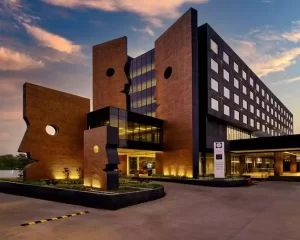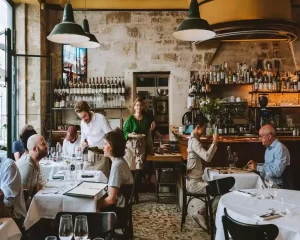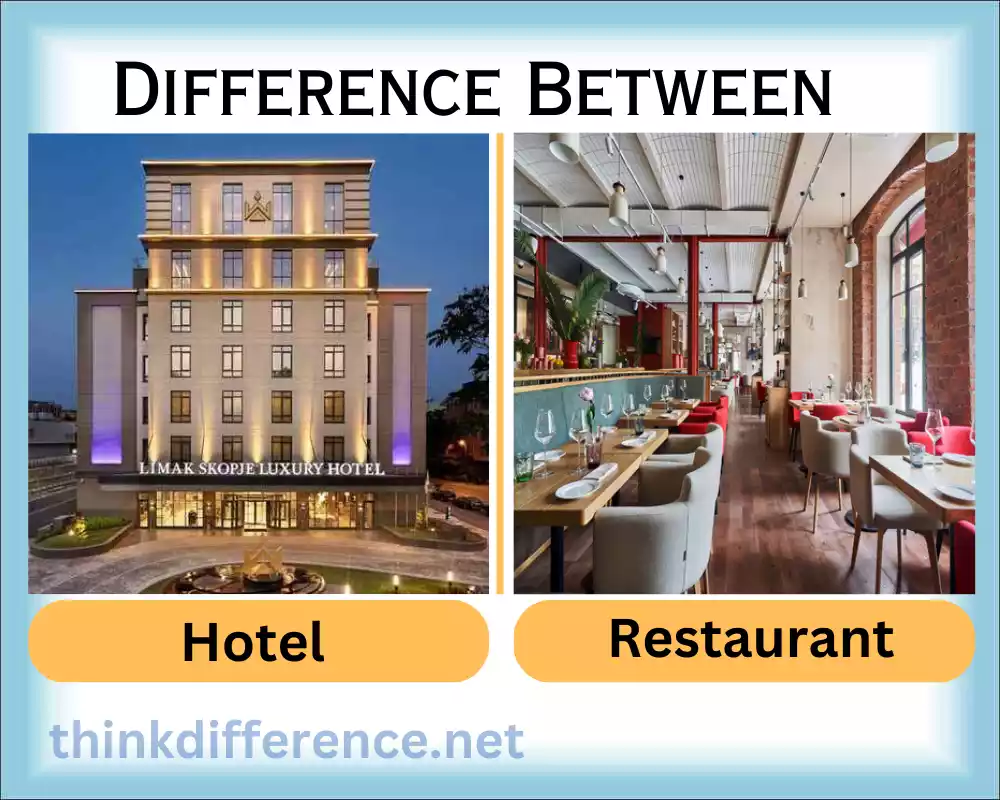Definition of Hotel and Restaurant
Hotels provide temporary lodging to guests and hospitality services for them during their visit, from single-night stays up to longer stays and everything in between. Their rooms may cater to individuals or groups. Typically from individuals seeking budget travel accommodations to luxury guests with high expectations of amenities and sizes available to meet them all.

Hotel services and amenities are designed to make guests’ stays convenient, from room service and housekeeping services to concierge offerings and beyond. Their quality can be measured against their star rating.
Hotels play an indispensable role in travel and tourism by offering accommodation to business and leisure travelers alike. Their goal is to create an inviting and comfortable experience for guests; thus they’re found all across urban areas, resorts, and transport hubs to meet various traveler’s needs.
Restaurants provide food and drinks to customers for whom they pay. A restaurant allows its clients to dine in or place take-out orders. Each establishment may vary in its size, style, and cuisine depending on its customers’ dining experiences and culinary preferences.
Restaurant menus usually feature an expansive variety of food offerings ranging from appetizers and main dishes, desserts, and beverages – as well as drinks – suitable to any theme or specialty of a particular establishment, from Italian or Mexican fare, Chinese/Mexican and American options depending on theme or specialty of establishments. Some Restaurants provide gluten-free vegetarian and vegan alternatives to meet customers dietary restrictions.
Restaurants provide many services beyond food preparation, such as taking orders and serving food and drinks to customers, maintaining cleanliness standards and customer satisfaction standards, and offering entertainment such as live music performances or themed events at their bars.
Restaurants strive to create an environment. Which their guests feel welcome while providing food and services. Restaurants may vary greatly in style and atmosphere – from fine dining restaurants with elegant interiors to quick, casual eateries specializing in quick meals.
Restaurants play an indispensable role in the culinary industry. As gathering spots, they allow individuals, families, or groups to gather to dine or commemorate special occasions as well as simply socialize while taking pleasure from tasty cuisine and beverages.
Importance of understanding the difference between Hotel and Restaurant
Understanding the difference between a hotel and a restaurant is crucial for several reasons:
- Meeting Accommodation Needs: Understanding the difference helps individuals select an accommodation option suited to their unique needs. Hotels provide excellent accommodations for long stays or overnight stays while restaurants can serve great meals; individuals should explore this distinction to select an optimal place.
- Planning Travel and Dining Experiences: Planning trips and dining experiences, it is vital that travelers distinguish between hotels and restaurants when selecting hotels for stays or meals. Travelers should carefully consider factors like location, amenities, and price; while individuals looking for unique cuisine or fine dining can select restaurants based on ambiance and cuisine preferences.
- Setting Expectations: Recognizing the differences between restaurants and hotels helps set realistic expectations. While restaurants focus on food preparation and service, hotels specialize more heavily in providing comfortable accommodation and hospitality; understanding these distinctions will assist individuals in setting reasonable expectations thereby increasing overall satisfaction levels.
- Making Informed Decisions: Knowing the differences helps individuals make informed decisions. They can evaluate and compare various options according to their needs, budget, and preferences; using this knowledge they can select a hotel or restaurant which best meets those requirements and experience positive encounters during their visit.
- Professional and Business Considerations: Hospitality and food industry professionals will find it crucial to comprehend the differences between restaurants and hotels. Hotel managers, restaurant owners, and staff must know their roles, responsibilities, and customer expectations to deliver exceptional experiences to their guests and customers alike. This understanding allows for improved services such as tailored offerings or exceptional experiences that leave lasting memories behind for customers or guests of both establishments.
Understanding the differences between hotels and restaurants is critical for selecting appropriate accommodations, planning dining experiences or travel adventures, managing expectations accurately, making informed decisions, and enjoying satisfying encounters in food service, both personally and professionally. This distinction must also be appreciated if people wish to pursue rewarding food service careers themselves.
What is Hotels?
Hotels provide guests with accommodation and hospitality services. As commercial establishments, hotels rent rooms or suites out for short or longer-term periods; guests may occupy them from just one day up until multiple weeks have elapsed.

Hotel rooms are created to offer guests a welcoming, relaxing, and enjoyable stay, providing amenities and services designed to improve their stay – such as comfortable beds and private bathrooms with amenities and services like television, Wi-Fi connectivity, in-room dining options, and television programming. Common areas in hotels may feature reception desks, lobbies, or concierge services which assist guests during check-in/check-out processes.
At some hotels, additional services and facilities may vary based on size and type. Fitness centers, swimming pools, spas, and restaurants may all offer additional facilities and services that cater to different guest needs and budgets – these could range from fitness centers and swimming pools to spas and restaurants – and accommodations like standard rooms, luxury apartments, or extended stay apartments may all be offered as part of a guest stay experience.
Hotels play an essential part in travel and tourism by providing temporary homes away from home to individuals traveling for both business and pleasure. Hotels provide travelers with a place to unwind from activities before resting comfortably; offering various services designed to make their stays pleasurable and fulfilling.
Hotel classification and standards may depend upon factors like amenities, services, and location. Hotels use various rating systems – like star ratings – to assess the level of service and quality offered and help travelers locate accommodations that suit them and meet their preferences.
Hotels provide essential travel services and amenities, providing guests with an enjoyable stay.
Types Of Hotels
Hotels of various kinds exist to meet the varying needs, budgets, and preferences of travelers. There is a vast array of hotels:
- Luxury Hotels: Luxury hotels are known for offering outstanding services, exquisite accommodations, and superior amenities. Many feature high-end restaurants and spas as well as fitness centers and other luxury features to create an exceptional and indulgent experience for their guests. Premium service with attention paid to detail ensures an exceptional and unforgettable stay experience at these establishments.
- Boutique Hotels: Boutique hotels are distinguished by their intimate atmosphere. Offering guests unique experiences sets them apart from other hotels. Boutique properties often focus on providing guests with memorable stays through personalized services and unique experiences.
- Resort Hotels: Resort Hotels are accommodations situated at popular vacation spots such as tropical islands, beachfront resorts, or mountain retreats that feature numerous facilities and amenities for leisure travelers – such as multiple restaurants, swimming pools, spa services, or recreational activities – making them attractive vacation choices. Many may offer all-inclusive package deals too.
- Business Hotels: Hotels that specialize in catering specifically to business travelers provide amenities and services tailored to their needs, often near convention centers or business districts. Amenities such as meeting rooms, business centers, high-speed Internet access, and transportation options make these accommodations the go-to hotels for business travelers.
- Budget Hotels or Economy Hotels: Also referred to as budget or economy hotels, these establishments provide basic amenities at an economical cost, making them the ideal solution for those wanting to save money without forgoing basic comfort or cleanliness. While budget hotels might limit some services or amenities available to them, they still provide an inexpensive yet comfortable place for visitors to rest their heads during their visit.
- Extended Stay Hotel: Extended stay hotels specialize in long-term accommodations for guests needing short or extended stays; usually weeks or even months at a time. They feature spacious rooms and suites equipped with either full or partial kitchen facilities to allow their guests to cook their meals, making this type of hotel suitable for long-term assignments, relocation needs, or anyone needing temporary lodging arrangements.
- Bed and Breakfast (B&B): Bed and Breakfast (B&B) establishments tend to be smaller and family-owned businesses offering an intimate experience for visitors. Many feature limited guest rooms; breakfast is typically included. B&Bs have earned themselves an excellent reputation for warm hospitality, homey vibes, and personalized care.
- Casino Hotels: These hotels typically exist in areas that specialize in gambling and entertainment, featuring casinos as their central draw. In addition, these establishments often include restaurants, bars, and live performances on premises as part of their offerings.
- Spa Hotels: Hotels dedicated to relaxation and well-being provide facilities such as hot tubs and saunas as well as rejuvenating activities and treatments designed to promote health and well-being.
These hotels cater to your specific needs and tastes, giving you plenty of choices that suit them all.
What are Restaurants?
Restaurants provide an alternative place for diners to eat outside their own home, without accommodation; their main feature being food or beverage services to their clients. Each major city features many such establishments offering international cuisine in beautiful environments – some licensed for serving alcohol – while other specialize in specific cuisine such as Chinese, Italian, Thai, or Japanese fare.

Some hotels are known for the quality of the restaurants more than for accommodation services; all hotels feature restaurants open both to guests with rooms booked as well as those outside, to maximize revenue generation and build customer relations.
Types Of Restaurants
There are various types of restaurants, Here are some common types of restaurants:
Fine dining restaurants provide an opulent dining experience. These venues typically boast formal decor and serve high-quality cuisine prepared by highly-skilled culinary teams with highly trained culinary teams and attentive waitstaff; all aimed at providing excellent service, gourmet dishes, and quality ingredients at premium prices – but prices for fine dining establishments may differ considerably from others.
- Casual Dining Restaurants: Casual dining restaurants provide an inviting, comfortable setting aimed at satisfying a broad spectrum of clients. Their diverse menu offers comfort foods along with popular items. Casual dining restaurants focus on maintaining the balance between quality and affordability while maintaining efficient services to achieve this atmosphere.
- Fast Casual Restaurants: Fast casual restaurants combine the ease and speed of fast food with freshness and quality casual dining, providing counter service as well as self-seating seating options for customers. Many focus on healthy menu items with customizable ingredients or toppings so customers can select what works for them.
- Ethnic Restaurants: Ethnic restaurants are restaurants that specialize in regional or international cuisines that reflect their host cultures or countries – whether this means Italian, Mexican, Chinese, Indian, Thai, or Japanese food as examples of such. Ethnic restaurants showcase ingredients and culinary traditions unique to each culture through the foods served therein.
- Family-style Restaurants: Restaurants designed specifically to serve families and large groups typically provide an extensive menu that suits a range of age groups, creating a casual, friendly environment with communal seating or large tables that encourage interaction and sharing among diners.
- Buffet Restaurants: Buffet restaurants provide customers with an ideal dining experience, offering a large variety of food that customers can sample without restrictions for one set price. Customers have unlimited access to this buffet restaurant’s offerings including appetizers, main dishes, side dishes, and sweet desserts – something customers tend to gravitate toward because of the flexibility of self-service dining experience.
- Cafes and bistros: Cafes and bistros provide casual dining in an informal and comfortable serving light fare sandwiches, salads, and pastries. Cafes often boast relaxed environments while bistros typically provide more formal experiences for patrons to dine.
- Fast Food Restaurants: Quick Service with Convenient Dining Solutions Fast food restaurants provide quick service with convenient dining solutions, featuring standard dishes that can be quickly prepared and served quickly – often associated with fast service or grab-and-go meals.
- Seafood Restaurants: Seafood restaurants feature an assortment of fish, crustaceans, and shellfish from around the globe that is supplied directly by fishermen in local regions and communities. Some can provide either casual dining experiences or more formal settings; some might provide raw-bar services with oysters and clams available as options.
- Vegetarian and Vegan Restaurants: Vegetarian and vegan restaurants cater specifically to people following plant-based diets, offering meals made solely of plant-based ingredients – often offering alternative meat dishes like veggie burgers! Vegetarian and Vegan restaurants place a high emphasis on sustainability and ethical food practices when selecting menu items.
Below is a selection of restaurant types currently available to customers, each providing its own dining experience, cuisine, and atmosphere suited for customer preferences, dietary restrictions, or any special events or occasions.
Differences Between Hotels and Restaurants
Hotels and restaurants both serve different functions and offer varied services to their guests, so understanding their differences will enable people to make better choices when dining or staying overnight. Here are a few key differences:
Purpose and primary service:
- Hotels: Hotels provide accommodation and hospitality services to their guests. Rooms or suites may be offered either temporarily or permanently to allow a comfortable and enjoyable stay for their patrons.
- Restaurants: Restaurants aim to give their patrons an enjoyable dining experience, which starts by creating delicious cuisine and offering great customer service. Their focus lies primarily on creating meals from scratch and serving them to patrons.
Duration of guest interaction:
- Hotels: Most guests opt for longer-term accommodations when visiting hotels – from one night up to several weeks or months depending on individual needs.
- Restaurants: Interactions between guests and restaurant staff tend to be brief; interactions often center around how long a meal takes from being quickly served to leisurely being enjoyed at a leisurely pace.
Range of services:
- Hotels: Hotel services go well beyond accommodations, they encompass concierge, housekeeping, and room services as well as amenities like pools, fitness centers, and conference rooms.
- Restaurants: Restaurants have always been known to specialize in providing great menu selection and table service, offering customers various meals and beverages, taking orders directly from them, and fulfilling those needs on behalf of a kitchen crew.
Facilities and amenities:
- Hotels: Hotels provide rooms equipped with beds and bathrooms as well as additional features, like televisions, minibars, and in-room dining options. In addition, most include common areas like lobby reception desks as well as spa and business centers for guest use.
- Restaurants: Restaurants provide dining areas for customers to sit comfortably while they enjoy their meals, with tables and chairs as well as possibly having their bar to provide drinks to guests. A pleasant and pleasant dining environment should always be created for maximum guest experience.
Guest expectations and experiences:
- Hotels: Hotel guests expect comfort, convenience, and hospitality from their stay in hotels. Hotels strive to make guests feel at ease by providing services such as room cleaning, attentive service, amenities, and other guest comfort features.
- Restaurants: Guest expectations of restaurants typically center on food quality and dining experience, such as delicious meals with pleasing presentations that meet guest standards for pleasing presentation and attentive service complemented by creating an inviting ambiance.
When selecting a restaurant or hotel, it’s essential to understand their differences and tailor experiences accordingly. Both hotel and restaurant experiences offer different kinds of cuisine as well as hospitality or dining excellence – with their offerings differing depending on individual needs and individual experiences.
Conclusion
Hotels and Restaurants are the backbone of the hospitality industry, catering to travelers and diners worldwide. Their impact on the economy, culture, and local communities is profound. As they embrace technology, sustainability, and exceptional service, the future looks bright for this ever-thriving sector.



